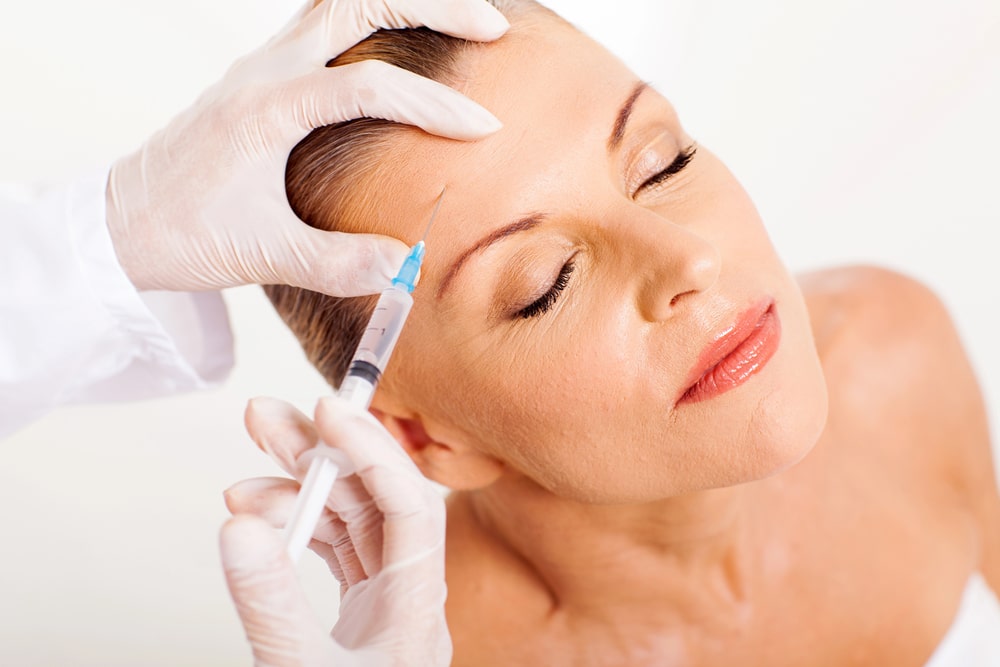Botox injections are a popular and highly effective treatment option for smoothing moderate to severe facial wrinkles including forehead lines, frown lines between the eyes, crow’s feet, and more. For those considering Botox injections in the forehead area, knowing what to expect in terms of possible side effects is key.
At A Glance
- Botox is an injectable neuromodulator used for cosmetic treatments as well as medical conditions including chronic migraine, overactive bladder, and neck pain.
- Most patients experience no side effects or only mild, transient side effects after cosmetic Botox injections to the forehead.
- If you experience more serious side effects, seek medical attention as soon as possible.
Side Effects Of Botox On The Forehead
The likelihood of experiencing the side effects listed below depends on a variety of factors including the amount of Botox injected, the skill of the practitioner, the location of the injections, and the sensitivity of your skin.
1. Pain Or Swelling Near The Injection Site
These are two of the most common side effects post-botulinum toxin injection. Fortunately, they usually resolve on their own within 1 to 2 days. Applying a cool washcloth to the injection site and taking over-the-counter painkillers may help reduce symptoms.
2. Bruising
Any bruising or skin discoloration you experience following Botox injections should resolve within a few days to a week, at most. The likelihood of this type of reaction occurring can be reduced by applying an ice pack to the forehead immediately following treatment.
3. Headaches
Headaches after Botox treatment may be related to muscle spasms caused by the medication. They are usually not serious and can be treated with over-the-counter painkillers.
4. Droopy Eyelids
A droopy eyelid (known as blepharoptosis) or a droopy eyebrow (known as ptosis) is a less common side effect of Botox injection to the forehead muscle. These types of issues usually clear up within 3 to 6 weeks, but may take longer to resolve or require medical attention, depending on the circumstances.
5. Dry Skin
Dry skin following Botox injections may be caused by reduced sweat production in the treatment area. Applying a dermatologist-approved moisturizer usually resolves the issue.
6. Upset Stomach
Some patients experience nausea, constipation, or indigestion following Botox treatments. Symptoms can usually be effectively managed by resting, staying hydrated, and taking over-the-counter medications, if necessary.
7. Dysphagia
Dysphagia (difficulty swallowing) is a rare side effect of Botox treatment that usually resolves within 2 to 10 days. If you experience this symptom, consulting with your doctor is recommended.
8. Eye/Vision Problems
Some patients experience dry eyes, eye irritation, or eye pain following Botox treatment to address forehead wrinkles. While such symptoms can often be resolved with over-the-counter saline eye drops, seek a medical evaluation if you have double vision, difficulty judging distances, or other more serious symptoms.
Is Botox Still Safe?
Yes, Botox is FDA-approved and considered to be a safe and highly effective treatment for forehead wrinkles in the vast majority of cases. Neuromodulator injections, including Botox, represent the most popular minimally invasive cosmetic procedure in the U.S., with over 9 million procedures performed annually.
Why You Should Only Trust Licensed Practitioners
Receiving Botox injections from an experienced, board-certified dermatologist is the best way to achieve natural-looking results and reduce your risk of side effects.
When To Consult A Doctor
Seek medical attention immediately if you experience any of the following severe or potentially life-threatening symptoms following a Botox cosmetic procedure:
- Difficulty breathing or swallowing (allergic reaction)
- Chest pain
- Muscle weakness
Where You Can Receive Safe And Effective Botox
Seeking Botox in NJ? Schedule an appointment with Dr. Ros and our world-class team at Dermatology Institute and Laser Center today!



